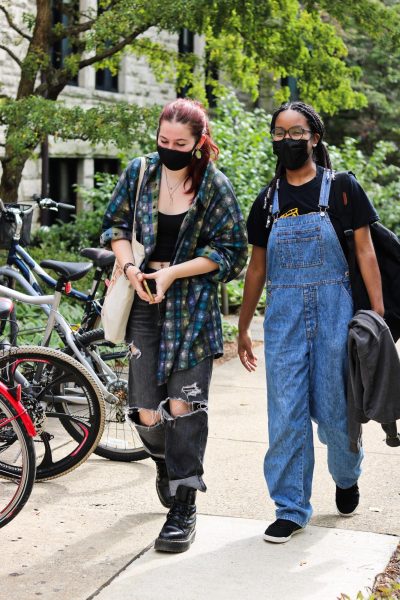College’s Financial Struggles Exacerbated By Lack of Alumni Donations
Over the course of this semester, I have been privy to a fair amount of discourse surrounding Oberlin’s financial situation. Specifically, I have heard students criticize the way the College is handling its finances, asking why it can’t tap more into the endowment, and protesting specific cost-cutting measures the administration takes in order to balance the budget. While this is a critical conversation to have as the College passes costs onto students and employees in the form of high fees and low pay, it is important to consider why the College is having financial trouble in the first place. It is possible that, as many students claim, mismanagement of the endowment is a contributing factor. However, a much clearer and potentially more important factor in the financial strain Oberlin is facing is a lack of donations from our alumni.
From 2013 until 2019, Forbes released the Grateful Grad Index, a 100-point scale that considers the percentage of alumni that give to a school and the median alumni donation size. The magazine lists the top 200 private, nonprofit colleges by that measure. While the claim that the formula can really measure gratitude is debatable, it is a useful source of data on how alumni donation rates compare across colleges. According to the most recent iteration of the index, Oberlin ranks 43rd, with a seven-year median donation of $11,918 and a three-year alumni giving rate of 22 percent for a score of 90. While that may seem impressive, it puts us in 12th place out of our 16 peer institutions.
One thing this metric fails to take into account is the opportunity for different types of non-monetary success. Many Obies make significantly less money than graduates of our peer institutions, typically opting to go into academia or public service over higher-paying jobs in the private sector. While this is a point of pride for the College — our slogan is, after all, “Think one person can change the world? So do we” — it also makes it difficult to remain financially stable without having to make dramatic changes to the budget. The Grateful Grads Index of a given institution is positively correlated with the median salary of that school’s alumni at 34 years old (about 12 years after graduation). In fact, adjusting for income, Oberlin moves up to sixth place among our peers. Yet while low alumni salaries play a role in our lack of donations, having a slew of extremely wealthy alumni is not the goal of our institution. The people who make the biggest difference in the world aren’t the ones who make millions.
All this being said, Oberlin’s low-end alumni salary numbers don’t necessarily mean we are doomed to a lack of donations forever. There are plenty of factors not related to alumni wealth that the College can focus on. For alumni who do have means, the College can concentrate on standing out as a worthy recipient of donations. Where people donate their money is largely determined by which organizations they deem to be the worthiest of their gifts.
“Oberlin is just one of 1.2 million nonprofit organizations in the U.S.,” the office of Vice President for Advancement Mike Grzesiak wrote in an email to the Review. “Across nonprofits the rate of participation in philanthropy has declined over the past few years. Today’s donors are pulled in countless directions (disaster relief, political campaigns, pandemic, social movements, etc.) and their philanthropy can vary from cause to cause.”
If Oberlin is going to improve — or even sustain — our donation numbers, we will have to come up with better ways to highlight why donating is so important.
“The best way to improve financial support for Oberlin, and any institution, for that matter, is to communicate the importance and impact of a donor’s gift,” Grzesiak wrote. “At Oberlin, we work to demonstrate how philanthropy makes a difference in students’ lives, whether in the classroom, in a time of emergency or financial need, or on the stage, field, or court.”
The Oberlin website highlights that almost nine out of 10 unrestricted donor dollars go toward financial aid, which is a good first step, but it isn’t enough. Plenty of potential donors have withheld support because of what they see as inefficient use of funds, especially in the wake of the austerity measures taken during the pandemic. It becomes a vicious cycle: the institution doesn’t receive enough in donations to balance the budget, so it has to pare down spending and make difficult, and sometimes misguided, decisions about where to cut costs. Alumni hear about these changes and decide, rightly or not, that the College is taking poorly thought-out measures and being irresponsible with its finances. Because of this, they hold back a portion or all of their donation, putting even more financial strain on the institution, which then has to make more difficult decisions. Thus, the cycle continues. We can escape this rhythm, but it will require the administration to make more careful financial decisions. Alumni will also have to cut the administration a bit of slack and provide some of the funds to get the ball rolling in a better direction.
Another important thing to keep in mind is that we have to demonstrate how donations to Oberlin impact the world outside of Oberlin.
“With regard to inspiring alumni giving (and participation), we best serve the students and faculty of Oberlin when we are able to tell of their achievements, successes, and impact on the world and relate that to how philanthropy helps make those achievements and successes possible,” Grzesiak wrote.
If we can find ways to tell meaningful stories of alumni who have used what they learned at Oberlin to become Nobel and Pulitzer Prize winners, professors, journalists, politicians, and diplomats, and we can articulate what Oberlin programs shaped them and helped them achieve what they did, we can inspire alumni to donate so that the College can contribute to the next generation of changemakers.




